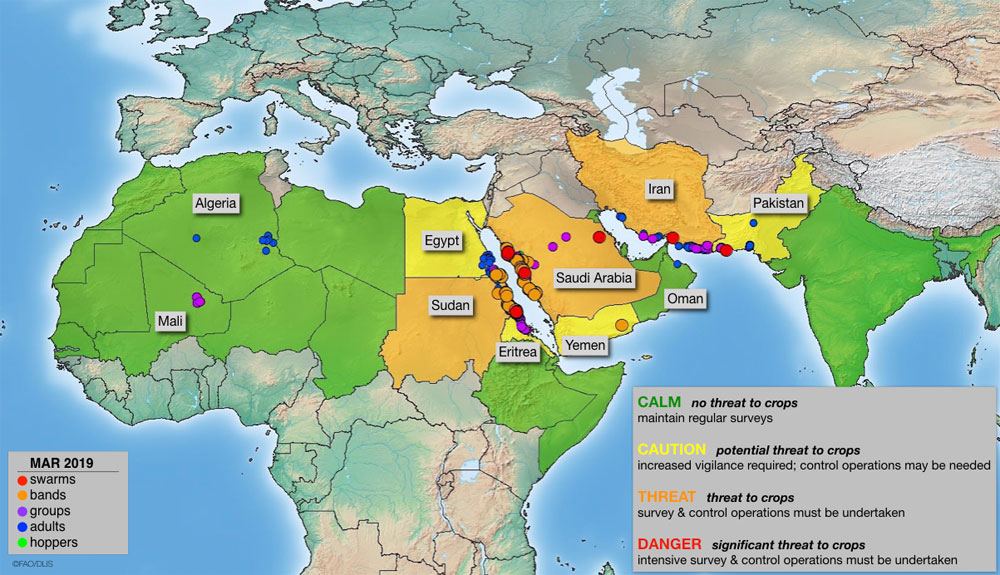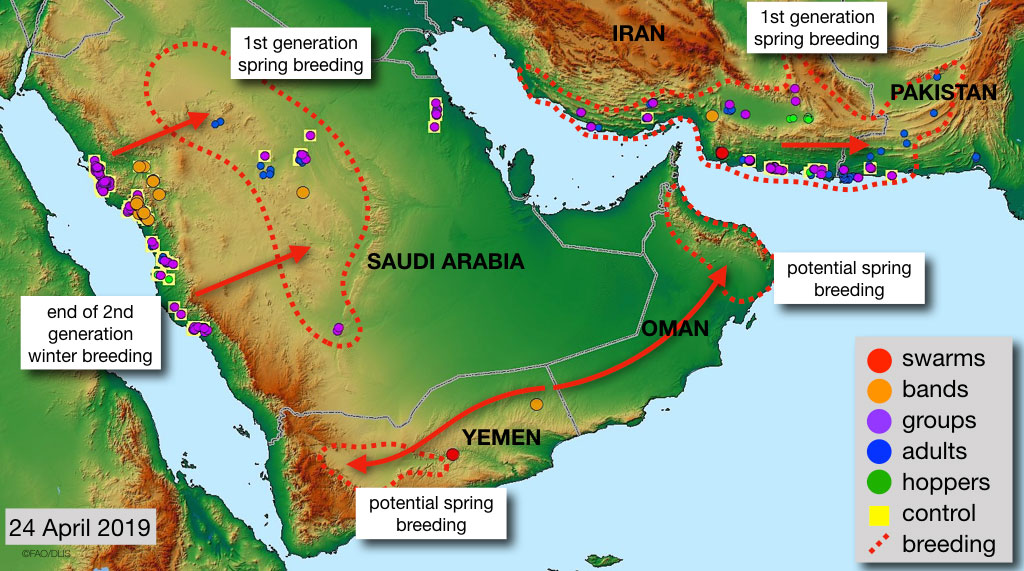First up, The U.N. FAO Locust Watch:
Desert Locust situation update 24 April 2019
Locusts increasing in spring breeding areas of Southwest Asia and Arabia
Desert Locust breeding is underway in the traditional spring breeding areas in southeast Iran, southwest Pakistan and in the interior of Saudi Arabia.

In Iran, groups of adults first arrived on the southern coast in late January from the Arabian Peninsula, about a week after FAO DLIS issued a warning. Additional groups and swarms appeared in February and March, spreading eastwards along the coast where they laid eggs that began to hatch from mid-March onwards. The hoppers formed small groups and a few bands. Although control operations were immediately launched, breeding has continued because of good rains and favourable ecological conditions. Currently, hoppers, adults and groups of hoppers and mature adults are primarily present on the southeast coast between Jask and Chabahar and in the Jaz Murian Basin of the interior. Smaller infestations are present further west along the coast and in interior areas near Bander-e Lengheh. Reports indicate that nearly 12 000 ha have been treated since February.And from the Tasnim News Agency (Iran), April 16:
In Pakistan, a small swarm first appeared on the southwest coast in mid-March followed by several groups of adults that laid eggs. Hatching started in early April, causing small groups of hoppers to form. Control teams have treated more than 600 ha so far. Low numbers of mature solitarious adults are present in the interior of Baluchistan where breeding is expected.
In Saudi Arabia, a second generation of breeding is coming to an end in the winter areas along the Red Sea coast while a first generation of breeding has started in the spring areas of the interior where groups of adults laid eggs between Gassim and Hail. Aerial and ground teams have treated more than 76 000 ha so far this year....MORE
Locusts from Arabian Peninsula Threatening Iran (+Video)
TEHRAN (Tasnim) – A locust outbreak in the Arabian peninsula has been spreading to Iran, threatening crops and food security in large areas of the coastal province of Hormozgan, an official said.
Director of a department at Horkozgan’s agricultural organization told Tasnim that Iran is facing the worst locust attack in the past 40 years.
He said several swarms of locusts have come from the Arabian peninsula to Iran over the last 10 weeks, some of which have penetrated into farmlands of the province as far as 200 kilometers from the coast.
The UN Food and Agriculture Organization (FAO) said in February that a locust outbreak in Sudan and Eritrea was spreading rapidly along both sides of the Red Sea to Saudi Arabia and Egypt.
The FAO also noted that good rains have allowed generations of locust breeding since October 2018, leading to a substantial increase in locust populations and the formation of highly mobile swarms.I suppose the Mossad will be taking credit for this as well as the drought ("Israel is stealing our clouds") and then the floods that hit a couple weeks ago.
The UN agency had also highlighted the control measures in Iran after at least one swarm arrived on the southern coast at the end of January.
Adult locust swarms can fly up to 150 km a day with the wind and adult insects can consume roughly their own weight in fresh food per day. A very small swarm eats as much in one day as about 35,000 people, posing a devastating threat to crops and food security....
Locast Watch developments, 2018-2019 season:
October 14, 2018
"Saudi Arabia—Oh Just ^#@&*%^ Great: Now There's A Cyclone Bearing Down That's Going To Jumpstart The Locusts"
December 6, 2018
In Some Positive News, The Desert Locust Situation Remains Calm
January 13
Locust Watch: Situation Deteriorating Rapidly
February 4
Locust Watch Situation Update: "A Desert Locust outbreak is in progress on the Red Sea coastal plains..."
